On April 15th 1985, in a temporary arena built on the tennis courts of Caesars Palace in Las Vegas, two fighters gave us everything and a little bit more.
One came for redemption, the other for greatness. They met head on, in the most dramatic, brutal eight minutes of action we are ever likely to see in a boxing ring.
The undisputed World middleweight title was the prize, but much more was on the line during a truly unforgettable night. Both combatants were seemingly on a mission that night, with one succeeding in brisk fashion.
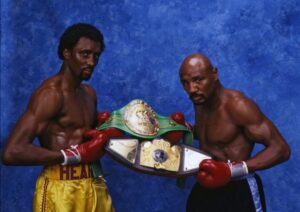
We can all create illusions of the past, but those two fighters – in that Vegas ring – went to work in the most simplistic way that even now, an astonishing 35 years on, the magic lives on. It was one of those nights.
‘Marvelous’ Marvin Hagler, the formidable and destructive, long-reigning champion had cleaned out his division since ripping the title away from Alan Minter on an unsavoury night in London, in 1980.
But in the eyes of many, maybe even Hagler himself, the champion needed to do more to convince the masses that he was indeed a true great. He wanted to show that he was more than just a champion.
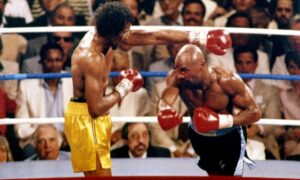
The wait was over for the shaven-headed middleweight master, as he and the rangy Thomas ‘The Hitman’ Hearns would cross paths. After an initial failure to make the fight in 1982, Hearns had Hagler very much in his sights, determined to topple the fearsome champion.
‘Sugar’ Ray Leonard had taken away the unbeaten record of Hearns in 1981, but the Detroit native had recovered at least some of that former invincibility. A second round demolition of the legendary Panamanian, Roberto Duran, in 1984 reinvigorated the ‘Motor City Cobra’, catapulting him towards the Hagler fight. And what we witnessed on that Spring evening will never be forgotten.
Respected commentator Ian Darke was ringside for that monumental evening, covering the fight for BBC Radio. Earlier this week, ahead of its 35th anniversary, I had the pleasure of speaking to Darke about the fight.
Even before I could ask the obvious question Darke beat me to the punch, saying, “It was the best fight I ever covered – from all of the fights I did for radio or television. It was eight minutes of spellbinding fury. The atmosphere around it was electric from the moment we got to Las Vegas.”

The betting lines had Hagler a very narrow favourite, with late money on Hearns seeing the fight become a virtual even fight. Darke also favoured the Kronk star at the time of the opening bell.
“Hagler oozed a lot of menace and was the natural middleweight. But a lot us were thinking that Hearns would detonate that right hand and take Hagler out, and that was the way I was leaning.”
Colin Hart, veteran boxing journalist, was also there covering the fight with Darke, and he too was astonished by what he saw in that mesmerising opening round.
“Colin is never short of a word or two,” quipped Darke. “But when that breathless first round ended, Colin literally couldn’t speak. It had literally taken his breath away. After a few seconds he managed to splutter out the line, ‘That was the greatest round of boxing I have ever seen in my life.’ And it was.”
The voice of Darke had a unique way of relaying a fight back to its listeners, often making the contest sound far more exciting than it actually was.
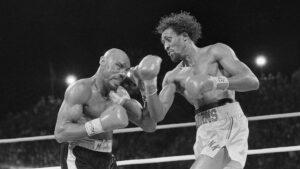
“When I got back home to London, I received a letter from a guy who was an amateur boxing coach from Kent. He said, ‘I very much enjoyed the fight, it sounded like a good one. But what you didn’t tell me was how many punches were being slipped and parried.’ He obviously hadn’t seen the fight yet, only heard it. So I politely wrote back saying that when you get to see the fight you will know that not a lot of punches were slipped or parried.
“Looking back at some old notes, a lot of people thought Hagler would try and dance and move – trying to stay out of the way of Hearns’ big right hand. But Hagler said after the fight at the press conference, ‘This is my domain, this is my division, if you want a tear-up, come on then.’ That’s what made it such a good fight, a last man-standing type of fight.”
Hagler, despite winning the fight, was covered in blood, and at the time it appeared as though there was a real risk of the fight being stopped. Darke revealed, “The referee Richard Steele went to the corner of Hagler, and said to him, ‘Can you see OK?’ and Hagler replied, ‘I’m not missing him, am I?”
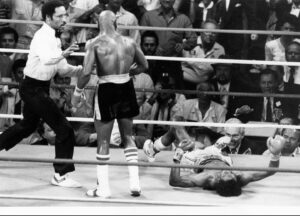
The first round is, without too much argument, considered the greatest round in boxing history. I asked Darke how he managed to commentate on it, with so much frantic action to relay to his audience, sitting at home on tenterhooks.
“…with difficulty. On the radio you are the eyes for the listener. Trying to keep with up that level of frenetic action was practically impossible. All you can do is give the listeners an impression of what is going on.”
At the end of the opening round, with Hagler absorbing the best of Hearns, it appeared, albeit with the benefit of hindsight, that the champion had the fight won. But watching it live and from ringside, the general consensus was anything but.
“I don’t remember at the end of the first round thinking the fight was over, because both were still landing bombs on each other, and you still thought one might knock the other out. I think even in the second round, Hearns hit Hagler with a right hand that seemed to buckle his legs a little bit. But you could see then that bit-by-bit, Hagler was getting the better of the argument. I didn’t get that impression at the end of the first round.”
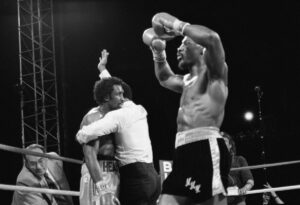
The champion looked to be in control in the third round. Hearns was visibly wilting, his legs were betraying him and he looked as though he was at breaking point. But with Hagler covered in blood, referee Steele momentarily stopped the action, with the champion on the brink of victory. Suddenly, the Petronelli-trained fighter’s title looked in real danger.
“I didn’t think Steele would stop the fight, I think there would have been uproar. I didn’t think the cuts were that bad at the time, in terms of them stopping the fight. But if the fight had gone longer, then it would have been a bigger problem. But it was never going to be a long fight at that sort of intensity.”
Hagler famously went into isolation before his fights, and there was a stark contrast between how the two prepared for this event. Hagler spent his camp in relative solitude; Hearns operated in a more public manner. Even on his biggest night, the champion didn’t celebrate his victory too much.
“The great story after the fight was that Hagler declined the million-dollar suites that were usually on offer. Hagler just wanted a simple room. He put his two trainers, Pat and Goody Petronelli in a single room, sharing.
“After the fight, Hagler just celebrated with some soft drinks and water,” continued Darke. “One of the guys around the place, a publicist, said, ‘You got to do better than this,’ and ordered six bottles of champagne. Hagler had a little bit, but not much. Then, a few weeks later, he rang the guy and said, ‘What’s going on? I’ve just had a bill for $1,300 for this champagne.’ He had just made millions of dollars from the fight and he still challenged this bill.”
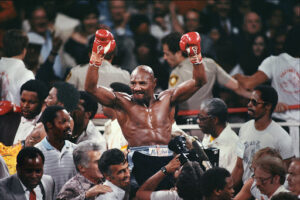
There was a narrative spun after the fight that this was a version of Hagler we hadn’t seen before. All the frustration of being denied the respect he felt he rightfully deserved looked as though it all came out on that April evening. Though Darke felt differently.
“I think Hagler always had a chip on his shoulder, right the way through to his retirement, that he never got the proper recognition. He did in the end, of course. But after everything I think Hagler was a cold and calculated professional. I think they thought as a camp, that Hearns would come out and try to land those big punches.”
“Hagler and his team thought that they were the punchers in this fight, not Hearns, and that Hagler was the full-blown middleweight. They rolled the dice on that, and [they thought] if Hearns wanted that type of fight then we will meet him head on. A straightforward collision and wear him down, and that’s exactly what happened. You have to say, Hagler got his tactics spot on.”
Very few fights, if any in the modern era, can match what was witnessed 35 years ago today. The most savage and unrelenting fight of a generation that included other memorable bouts fought amongst the heralded ‘Four Kings’ of Hagler, Hearns, Leonard and Duran.
In many ways both Hagler and Hearns created a very special piece of history on that April evening. That makeshift, outdoor arena was perhaps the most fitting venue for the fight, the ring an inconvenience, the judges an unnecessary addition. Hagler came for greatness, for respect and acceptance. Nobody could argue he left Las Vegas with anything less.
Article written by: Mark Baldwin
Follow Mark on Twitter at: @UFC21